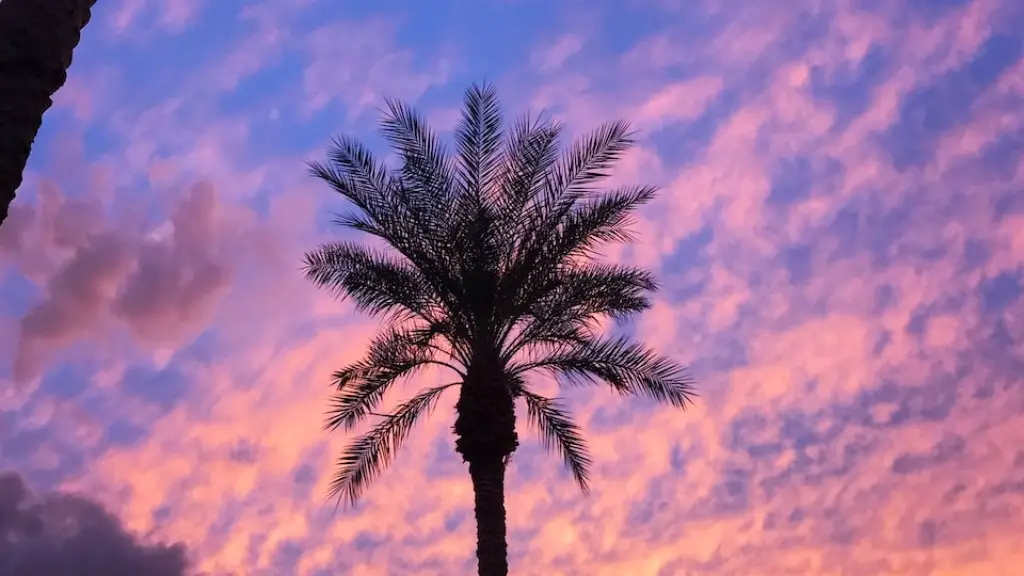Painting a palm tree in watercolor does not have to be complicated. All you need is a good quality watercolor paint and brushes, paper, and a few simple techniques. In this article, we will go over the steps you need to take to paint a realistic palm tree in watercolor.
Firstly, the most important factor in watercolor painting is your choice of paper. You should choose a cold pressed paper for best results, as it will enable the paint to flow evenly. A thicker paper will also be easier to work with when painting more complicated subjects. once you have your paper, it’s time to start sketching. You should draw a rough outline of the palm tree and its branches. This will serve as a guide as you add the color later.
Next, you want to begin applying the paint to your palm tree. Depending on the effect you want to create, your choices of color will vary. Generally speaking, you will want to use a combination of greens and browns for the trunk, with lighter greens for the palm leaves. Start by applying a light wash of green to the trunk and branches. Then use a darker green to add the finer details and texture. Add in darker and lighter tones of green to give the tree more depth and realism.
Now it’s time to add the sky and background elements. Begin with a light wash of blue to give your painting an atmosphere. You might want to add some wispy clouds too. If you’re feeling adventurous, try wetting your paper before you add the blue wash and see what intriguing effects you can create.
Once your background is complete, you can use a darker blue to add shadows to the palm tree. Carefully apply the paint in thin layers, experimenting with different tones and shades to create realistic shadows. As you work on the shadows, add some yellow and pink to the leaves, adding more depth and contrast. You can even use a dry brush technique to create a more rustic look.
When you are happy with the effect of your shadows, you can start adding the highlights. Carefully work in some lighter greens and yellows in areas that would naturally receive more light, like the tips of the leaves, or areas where the branches jut out from the tree.
Finally, you are ready to add the finishing touches. Any details you want to add, such as grass, buildings, or animals, can be done using dry brush and wet on wet techniques. Once you have added the details, use a clean, dry brush to soften the brush strokes and blend the colors. If needed, you can use some white paint to add highlights and reflections.
Materials
Painting a palm tree in watercolor doesn’t require complicated materials. However, it’s important that you pick the right ones. You need good quality watercolor paints and brushes, preferably an assortment of sables and ox-hair, depending on the type of brushwork you will be doing. Then you need thick, cold-pressed paper so that the paint can flow nicely. If you are feeling adventurous, you can try a thicker paper for a more textured effect.
Techniques
It’s helpful to understand a few basic watercolor techniques when painting a palm tree. Dry brushing is one technique you can use to add texture and realism to the trunk and branches of the tree. Wet on wet techniques are also useful for creating background elements like clouds, grass and buildings. And of course, you can use a combination of dry and wet techniques to create interesting and unique effects.
Practice
As with any art form, practice is the key to painting a great looking palm tree in watercolor. Start off with simpler paintings, using just a few colors and basic techniques. Once you are comfortable with the basic techniques, you can start experimenting with more complex effects like wet on wet, dry brushing and layering of colors. Don’t be afraid to practice and make mistakes; this is how you will learn and hone your painting skills.
Unique Ideas
If you are feeling creative, there are plenty of ways to make your palm tree painting stand out. Add a burst of color with a contrasting background, or go for something more surreal and add some strange objects in the foreground. You can also experiment with perspective and coloring to create an interesting, stylized effect. Have fun and be creative; the possibilities are endless.
Colors
Although the classic combination of greens and browns is the best choice for painting palm trees in watercolor, you can also be daring and experiment with other colors. Try adding some blue or red tones to the trunk and branches to create a unique look. Or how about painting the leaves in a warm yellow or gold to create a warm, inviting atmosphere.
Conclusion
As you can see, painting a palm tree in watercolor is not difficult; it just takes some patience and practice. Make sure you understand the basics before starting, as well as the techniques and materials you need. Utilize the tips and techniques given in this article and you’ll be sure to create some fantastic watercolor paintings of a palm tree.

